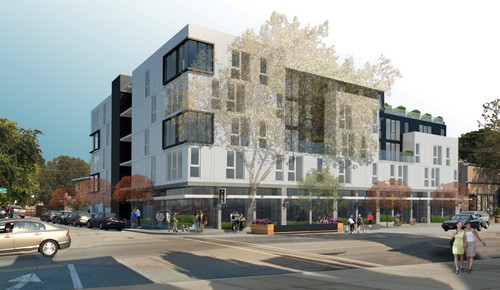Many California cities are in the midst of updating their "housing elements," a part of their General Plans. In the next year or so, many of these plans will be completed and certified, setting local housing development policy for the next eight years.
State laws have been shifting, forcing cities to be more rigorous in their plans to help meet state housing goals. In addition to bills like A.B. 2097, which prohibits cities from setting minimum parking requirements near transit - leaving it to the market to decide - other housing laws are changing too. Now cities must discuss barriers that keep them from meeting their assigned Regional Housing Needs Assessment (RHNA) - a state-assigned number of housing units they need to supply. For example, cities are now required to explore how their parking requirements contribute to holding back housing development.
TransForm - which has studied the impacts of parking regulations on housing and ground-truthed whether those required parking spots are even needed - followed the process of developing housing elements in about thirty Bay Areas cities. They commented on the parking issue and nudged the cities towards policies with better outcomes for housing supply.
Some of those cities have already changed their parking regulations. About eighteen of the cities TransForm followed have made commitments to update their parking rules, recognizing that they are constraining housing supply.
Knowing there is a dearth of good data, TransForm just published a guide for them and for housing advocates: Parking Revolution: Housing Solution. The timing is key, since these plans are being discussed right now.
While Parking Revolution: Housing Solution focuses on the Bay Area cities TransForm has closely studied, the reasoning is applicable to cities throughout the state.
Why Parking
For years, cities have required a minimum number of parking spaces to be built per new housing unit. This makes housing more expensive (a lot more expensive), takes up valuable space, and generates more driving and pollution. But there has been little political gain for local leaders to change the status quo, even if they recognize these problems as systemic. People are used to having easy access to plenty of parking, and tend to think of it as "free" if they're not paying for it as they use it. They even feel a sense of ownership over curb space in front of property they own, and vehemently resist sharing it or giving it up.
"The easiest thing [for leaders] is to require tons of parking everywhere," said Stuart Cohen, TransForm's founder and one of the authors of the guide. "In the context of not getting calls, maybe that's a good strategy. But in terms of climate, it's not."
In the past, cities could ignore their state-assigned RHNA without many repercussions, or pretend to comply by designating unbuildable land as ready for housing. The nine Bay Area counties are supposed to generate 441,000 homes by 2031, with 41 percent of those for people with low incomes. In the last decade, "we haven’t built at even half that rate," according to the TransForm guide. But the housing crisis and changing state laws are putting new pressure on cities to make a genuine effort to increase housing supply.
"It's a wholly different game in parking than it was even eight years ago, on the last RHNA cycle," said Cohen. "There's so much opportunity on parking [to increase housing]. For a long time people have been talking about density, but parking was ignored. It really took [UCLA Professor] Donald Shoup to ignite this movement, and give planners tools and vision and rational" for thinking about parking.
Yet in many places "parking policies are still really outdated, especially when you get away from the bigger cities," he added.
Guidance for Housing Advocates and Allies
TransForm has been studying the connections between parking and housing for years, developing tools like GreenTrip Connect to help planners and advocates visualize how much space and money can be saved by "right-sizing" parking.
According to Cohen, GreenTrip Connect is one of the few tools recommended by the state Housing and Community Development Department to help plan for parking. That's good - but it points to a problem. City planners and consultants lack data on these issues, which is why they rely on the ITE Trip and Parking Generation Manual. Since that is developed by engineers, it must be reliable, right? Because it recommends an exact number of parking spots for various types of land use, it also maintains an air of authority.
Professor Shoup does an awesome job explaining why that precision is a huge problem and why the Manual is not, in fact, reliable. But the fact remains that planners, being under-resourced and short on time, need reliable and quick tools.
Stuart says the TransForm report is pithy for that reason - to be as helpful as possible. But it also includes a brief background on why parking is important. "People are busy," he said. "And this is meant to be motivating."
While they could have written much more, the writers narrowed their guidance to just the top five things cities can do:
1) Reduce or eliminate minimum parking requirements citywide
2) Set parking maximums
3) Allow shared parking
4) Unbundle the cost of parking from rents
5) Require transportation demand management strategies such as transit passes and car-sharing
Then it offers tools, resources, and ideas for housing advocates to use to encourage their cities to adopt these changes.
"It's meant as a quick guide for people outside the agencies," said Cohen. "It can inspire city councilmembers or staff, but our audience is housing advocates and climate advocates."
The TransForm guide includes scenarios for each of the eighteen Bay Area cities that have committed to studying parking. It even analyzes one site identified in each of those cities' housing elements, using it to show how they can think about requiring less parking, and pointing out resulting climate and financial benefits.
The guide, and its tools, are available for anyone to use. Literally anyone - not just engineers or planners. While much of the data is specific to the Bay Area, where TransForm collected it, other parts of the tools, like the VMT outputs, are valid statewide.
"Parking Revolution: Housing Solution can help make the case for lowering parking requirements," said Cohen, "even if it can't provide specific data points for every place."






